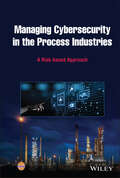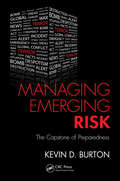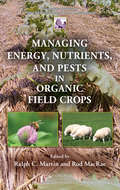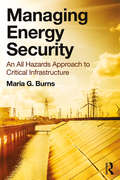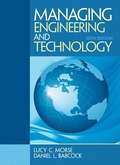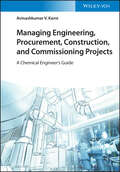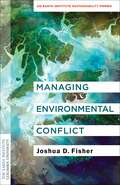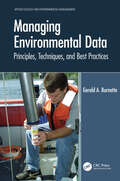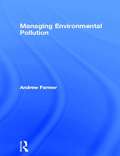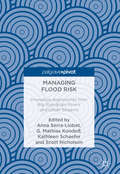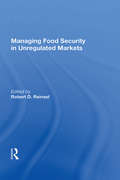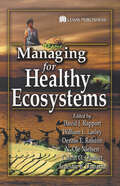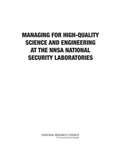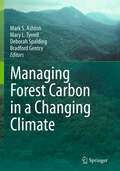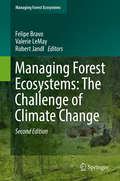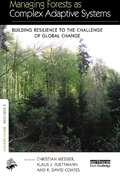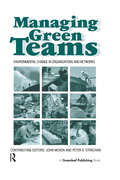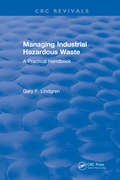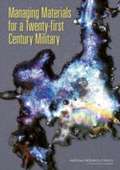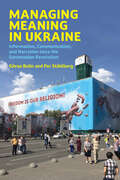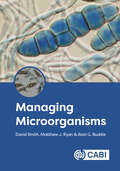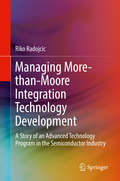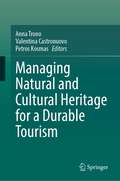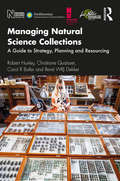- Table View
- List View
Managing Cybersecurity in the Process Industries: A Risk-based Approach
by CCPS (Center for Chemical Process Safety)The chemical process industry is a rich target for cyber attackers who are intent on causing harm. Current risk management techniques are based on the premise that events are initiated by a single failure and the succeeding sequence of events is predictable. A cyberattack on the Safety, Controls, Alarms, and Interlocks (SCAI) undermines this basic assumption. Each facility should have a Cybersecurity Policy, Implementation Plan and Threat Response Plan in place. The response plan should address how to bring the process to a safe state when controls and safety systems are compromised. The emergency response plan should be updated to reflect different actions that may be appropriate in a sabotage situation. IT professionals, even those working at chemical facilities are primarily focused on the risk to business systems. This book contains guidelines for companies on how to improve their process safety performance by applying Risk Based Process Safety (RBPS) concepts and techniques to the problem of cybersecurity.
Managing Emerging Risk: The Capstone of Preparedness
by Kevin D. BurtonFrom Main Street to Mumbai, Managing Emerging Risk: The Capstone of Preparedness considers the new global drivers behind threats and hazards facing all those tasked with protecting the public and private sector. The text delves into the global mindset of public and private sector emergency managers and presents a new risk landscape vastly different from the one existing ten years ago.The book begins by presenting a series of fictitious scenarios each resulting in mass destruction and fatalities. These are each followed by actual news stories that support the scenarios and demonstrate that the proposed events‘seemingly unthinkable have the potential to occur. Next, the author identifies two drivers in the practice of emergency management and general preparedness today that constitute our view of the future and the new face of risk. The first is the Disaster Halo Effectthe idea that modern threats exhibit more than one event. The second is the worldview of our nation as a Market State focused on the trading of goods, services, and ideas among the nation-states. The book also reviews the history of preparedness and discusses its relationship with large-scale threats, establishing that hindsight bias has hurt our ability to plan and respond to the unexpected.The chapters that follow explore what is needed to better cultivate, design, develop, and operate emerging management and preparedness thinking in the current environment. Each chapter begins with key terms and objectives and ends with thought-provoking questions. Introducing a new paradigm of thought that takes into account the chief influencers of global threats, the book arms emergency and business operations managers with the ammo needed to successfully confront emerging threats in the 21st century.
Managing Energy, Nutrients, and Pests in Organic Field Crops (Integrative Studies in Water Management & Land Development)
by Ralph C. Martin Rod MacRaeThe use of organic management practices in field cropping continues to rise globally, and these methods have proven to be a viable way to produce food with reduced resource use and environmental damage. Managing Energy, Nutrients, and Pests in Organic Field Crops challenges the popular misconception that organic systems are weak at managing energy,
Managing Energy Security: An All Hazards Approach to Critical Infrastructure
by Maria G. BurnsThis interdisciplinary book is written for government and industry professionals who need a comprehensive, accessible guide to modern energy security. Introducing the ten predominant energy types, both renewable and non-renewable, the book illustrates the modern energy landscape from a geopolitical, commercial, economic and technological perspective. Energy is presented as the powerhouse of global economic activities. To ensure the uninterrupted supply of energy, nations, industries and consumers need to have options. Efficient energy security planning ensures that when a primary energy source is depleted, compromised or interrupted, an alternative energy source must be readily available. For this reason, the foundations of energy security are built upon the five pillars of Sustainability, Independence, Efficiency, Affordability and Accessibility. The numerous case studies presented in this book demonstrate that energy security may be compromised in the absence of one out of these five ingredients. The book also entertains the Triple-E notion of Energy Efficiency, Environmental integrity and Economies of scale, used by governments and corporations for energy optimization. One of the key strengths of the book is its ability effectively to cover various scientific disciplines, and several energy types, while remaining comprehensible. This book will be of much interest to security or logistics professionals, economists and engineers, as well as policymakers.
Managing Engineering and Technology, Sixth Edition
by Lucy C. Morse Daniel L. BabcockManaging Engineering and Technology is ideal for courses in Technology Management, Engineering Management, or Introduction to Engineering Technology. This text is also ideal for engineers, scientists, and other technologists interested in enhancing their management skills. Managing Engineering and Technology is designed to teach engineers, scientists, and other technologists the basic management skills they will need to be effective throughout their careers. NOTE: The 2nd printing of the 6th edition of Managing Engineering and Technology is now available as of June 2014.
Managing Engineering, Procurement, Construction, and Commissioning Projects: A Chemical Engineer's Guide
by Avinashkumar V. KarreManaging Engineering, Procurement, Construction, and Commissioning Projects An invaluable real-world guide to managing large-scale and complex Engineering, Procurement, Construction and Commissioning (EPCC) projects Engineering, Procurement, Construction and Commissioning (EPCC) infrastructure projects require engineers from several disciplines to adhere to strict budgetary, scheduling, and performance parameters. Chemical engineers involved in EPCC projects are involved primarily in ensuring that the process plant is designed correctly and safely—interacting with the client, contributing to feasibility studies, selecting specific technologies, developing process flow diagrams, and other key tasks. Managing Engineering, Procurement, Construction, and Commissioning Projects: A Chemical Engineer’s Guide clearly defines the role of a chemical engineer in the EPCC industry and provides detailed and systematic coverage of each phase of an EPCC project. Drawing from their extensive experience in process design, optimization, and analysis, the author identifies and discuss each key task and consideration from a chemical engineer’s perspective. Topics include scope and process planning, construction support, operator training, safety and viability evaluation, and detail engineering. Provides a structured overview of the various challenges chemical engineers face in each project phase Introduces the essential aspects of the Engineering, Procurement, Construction and Commissioning industry Describes the roles of chemical process engineers in each phase of EPCC projects and in different EPCC industry positions Discusses the interaction of process engineers with other disciplines and clients Managing Engineering, Procurement, Construction, and Commissioning Projects: A Chemical Engineer’s Guide is a must-have resource for chemists in industry, process engineers, chemical Engineers, engineering consultants, and project managers and planners working on EPCC projects across the chemical Industry.
Managing Environmental Conflict: An Earth Institute Sustainability Primer (Columbia University Earth Institute Sustainability Primers)
by Joshua D. FisherConflicts frequently arise over environmental issues such as land use, natural resource management, and laws and regulation, emerging from diverging interests and values among stakeholders. This book is a primer on causes of and solutions to such conflicts. It provides a foundational overview of the theory and practice of collaborative approaches to managing environmental disputes.Joshua D. Fisher explains the core concepts in collaborative conflict management and presents a clear, practical, and implementable framework for understanding and responding to environmental disputes. He details strategies to bring stakeholders together in pursuit of collective solutions, emphasizing ongoing processes of dialogue, analysis, action, and learning. This collaborative approach can create new opportunities for stakeholders to better understand each other and the natural world, which enables more effective and context-appropriate environmental governance. The primer examines why and how system dynamics can constrain or expand the possibility of constructive management of conflicts. It features a case study from the Amazon Basin, where local communities, extractive industry operators, conservationists, and land managers have often clashed over access to natural resources, drawing out lessons to illustrate how to adapt the conflict management framework to distinct contexts.Managing Environmental Conflict synthesizes knowledge, methods, and practices spanning consensus building, collaborative governance, complex adaptive systems science, environmental conflict resolution, and environmental peacebuilding. Its presentation of this important and timely topic will be invaluable for academics and practitioners alike, including decision makers, scientists, and conflict management professionals.
Managing Environmental Data: Principles, Techniques, and Best Practices (Applied Ecology and Environmental Management)
by Gerald A. BurnetteFocused on the mechanics of managing environmental data, this book provides guidelines on how to evaluate data requirements, assess tools and techniques, and implement an effective system. Moving beyond the hypothetical, Gerald Burnette illustrates the decision-making processes and the compromises required when applying environmental principles and practices to actual data. Managing Environmental Data explains the basic principles of relational databases, discusses database design, explores user interface options, and examines the process of implementation. Best practices are identified during each portion of the process. The discussion is summarized via the development of a hypothetical environmental data management system. Details of the design help establish a common framework that bridges the gap between data managers, users, and software developers. It is an ideal text for environmental professionals and students. The growth in both volume and complexity of environmental data presents challenges to environmental professionals. Developing better data management skills offers an excellent opportunity to meet these challenges. Gaining knowledge of and experience with data management best practices complements students’ more traditional science education, providing them with the skills required to address complex data requirements.
Managing Environmental Pollution (Routledge Environmental Management)
by Andrew FarmerPresents a comprehensive introduction to the nature of pollution, its impact on the environment, and the practical options and regulatory frameworks for pollution control. Sources of pollution, regulatory controls, technological solutions, management and mitigation techniques and assessment tools, are examined in each key area: air, freshwater, and marine pollution, contaminated land and radioactive substances. Illustrated with a worldwide range of case examples this book offers an invaluable up-to-date guide to both the principles and practice of pollution management.
Managing Flood Risk: Innovative Approaches From Big Floodplain Rivers And Urban Streams
by Anna Serra-Llobet G. Mathias Kondolf Kathleen Schaefer Scott NicholsonThe past half century has seen an evolution in thinking from ‘flood control’ to ‘flood risk management’, recognizing that risk results from both hazard and vulnerability. Rather than rely only on engineering structures to reduce flood magnitude or extent, recent policies emphasize avoiding construction in flood-prone areas (or moving people from floodplains), reducing impacts on exposed populations through early warning systems, and insurance to aid in recovery. Implementing this new approach faces many challenges but also offers opportunities for synergies, as described in this book for a range of large floodplain rivers and smaller urban streams across North America and Europe. This book is unique in presenting the voices of those on the front lines of implementing a new paradigm in flood risk management, each river with a unique set of challenges and opportunities derived from its specific geography as well as differences in governance between the American and European contexts.
Managing Food Security In Unregulated Markets
by Robert D. ReinselThe major grain producing nations are moving toward the reduction of domestic and export subsidies to agriculture. The grain importing nations are reducing import barriers. As world markets evolve, grain will tend to be produced in areas that have a comparative advantage in grain production. Over time, production will shift to least-cost areas. Moving toward market orientation during the 1980's, the United States sharply modified its grain policy so that nonrecourse loans are no longer used as price enhancement devices. The loan rates are established at a percentage below the moving average price and now provide a safety net for prices when aggregate output is much larger than normal in relation to demand. This change tends to remove the United States from its long-term role as residual supplier to the world markets. U.S. grains are more likely to be priced competitively, and stocks are unlikely to accumulate in government storage.
Managing for Healthy Ecosystems
by David J. Rapport William L. Lasley Dennis E. Rolston N. Ole Nielsen Calvin O. Qualset Ardeshir B. DamaniaOne of the critical issues of our time is the dwindling capacity of the planet to provide life support for a large and growing human population. Based on a symposium on ecosystem health, Managing for Healthy Ecosystems identifies key issues that must be resolved if there is to be progress in this complex area, such as:Evolving methods f
Managing for High-Quality Science and Engineering at the NNSA National Security Laboratories
by Division On Engineering Physical SciencesThe three National Security Laboratories--Los Alamos National Laboratory (LANL), Sandia National Laboratories (SNL), and Lawrence Livermore National Laboratory (LLNL)--are managed by private-sector entities under contract to the National Nuclear Security Administration (NNSA). The FY2010 Defense Authorization Act mandated that NNSA task the National Research Council (NRC) to study the quality and management of Science and Engineering (S&E) at these Laboratories. This study (addressing a total of 5 tasks) is being conducted in two phases. This report covers the first phase, which addresses the relationship between the quality of the science and engineering at the Laboratory and the contract for managing and operating the Laboratory (task 4), and also addresses the management of work conducted by the Laboratory for entities other than the Department of Energy (task 5). The study's second phase will evaluate the actual quality of S&E in key subject areas. Managing for High-Quality Science and Engineering at the NNSA National Security Laboratories presents assessments of the evolution of the mission of the NNSA Labs and the management and performance of research in support of the missions, and the relationship between the Laboratory Directed Research and Development (LDRD) program and the ability of the Labs to fulfill their mission. The report examines the framework for managing science and engineering research at the Labs and provides an analysis of the relationships among the several players in the management of the Labs--the NNSA, the site offices, the contractors, and the Lab managers--and the effect of that relationship on the Laboratories' ability to carry out science and engineering research.
Managing Forest Carbon in a Changing Climate
by Mark S. Ashton Mary L. Tyrrell Bradford Gentry Deborah SpaldingThe aim of this book is to provide an accessible overview for advanced students, resource professionals such as land managers, and policy makers to acquaint themselves with the established science, management practices and policies that facilitate sequestration and allow for the storage of carbon in forests. The book has value to the reader to better understand: a) carbon science and management of forests and wood products; b) the underlying social mechanisms of deforestation; and c) the policy options in order to formulate a cohesive strategy for implementing forest carbon projects and ultimately reducing emissions from forest land use.
Managing Forest Ecosystems: The Challenge of Climate Change
by Felipe Bravo Valerie Lemay Robert JandlClimate change shaped the political agenda during the last decade with three issues as hot topics: commonly making the headlines: carbon budgets, impact and mitigation of climate change. Given the significant role that forests play in the climate system - as sources, sinks, and through carbon trading - this book update the current scientific evidences on the relationships between climate, forest resources and forest management practices around the world. By including the forest scientists' expertise from around the world, the book presents and updates a depth analysis of the current knowledge, and a series of case studies focused on the biological and the economic impacts of climate change in forest ecosystems in Africa, Asia, Europe and North and South America. The book will form a valuable resource for researchers and advanced students dealing with sustainable forestry, climate change issues and the effects of climate change on natural resource management.
Managing Forests as Complex Adaptive Systems: Building Resilience to the Challenge of Global Change (The Earthscan Forest Library)
by Christian Messier Klaus J. Puettmann K. David CoatesThis book links the emerging concepts of complexity, complex adaptive system (CAS) and resilience to forest ecology and management. It explores how these concepts can be applied in various forest biomes of the world with their different ecological, economic and social settings, and history. Individual chapters stress different elements of these concepts based on the specific setting and expertise of the authors. Regions and authors have been selected to cover a diversity of viewpoints and emphases, from silviculture and natural forests to forest restoration, and from boreal to tropical forests. The chapters show that there is no single generally applicable approach to forest management that applies to all settings. The first set of chapters provides a global overview of how complexity, CAS and resilience theory can benefit researchers who study forest ecosystems. A second set of chapters provides guidance for managers in understanding how these concepts can help them to facilitate forest ecosystem change and renewal (adapt or self-organize) in the face of global change while still delivering the goods and services desired by humans. The book takes a broad approach by covering a variety of forest biomes and the full range of management goals from timber production to forest restoration to promote the maintenance of biodiversity, quality of water, or carbon storage.
Managing Green Teams: Environmental Change in Organisations and Networks
by Peter Strachan John MoxenTo reach environmental excellence, organizations must unlock and channel the ideas and energies of their staff. This can only be achieved through the effective leadership and commitment of senior managers and the development of sound teamworking throughout the organization. To this end, forward-looking organizations have formulated a range of teams, including: environmental steering committees; environmental action teams; process improvement teams; and quality and environment circles. The aims of this book are to bring together practical experiences and theoretical developments in relation to the role of teamworking within the context of environmental management. Contributions from an international group of leading practitioners and academics present examples of how teamworking can be utilised to solve the complex and uncertain environmental challenges that organisations face. The book is divided into three key sections. The first section examines – in a number of different organizational contexts – the problems that confront managers during the process of forming and developing environmental teams. In the second section, the book examines how environmental teams can trigger changes in core operations and integrate environmental concerns in business decision-making at every level in the organization. In the final section, the focus of the book shifts to environmental networks and their role as inter-organizational co-ordinators. Managing Green Teams: Environmental Change in Organisations and Networks will be of particular interest to educationalists, consultants and practitioners. Teamworking is a well-established field, but, to date, no book has made any attempt to fully integrate teamworking and environmental issues.
Managing Industrial Hazardous Waste- A Practical Handbook
by Gary F. LindgrenHere is your new handbook full of information and guidance necessary to understand and comply with the myriad and complex hazardous waste regulations. This handbook explains the regulations regarding identification and listing of hazardous wastes, walks the reader through the three determinations for all manufacturing firms, gives in-depth explanations of applicable standards, outlines the DOT standards applicable to shippers of hazardous wastes, presents a philosophical basis for corporate compliance, gives "how to" for actions and the paperwork necessary for such a program, and concludes with some practical information not commonly found in textbooks or regulations. This essential resource for personnel with waste management responsibilities at manufacturing firms should prove a valuable resource. This book will assist these practitioners in establishing or modifying regulatory compliance programs. This valuable new book helps you to reduce waste generation, segregate hazardous wastes, reuse on-site or off-site, recycle or reclaim, treat to reduce hazards, secure land disposal, follow regulatory standards, use best management practices, and establish or modify compliance programs.
Managing Innovation in Japan
by Chihiro WatanabeWhy do some country's hi-tech firms innovate better than others? Why did hi-tech firms from the United States outperform such Japanese companies in the 1990s? Through a wealth of empirical evidence, the book compares the development trajectory of manufacturing technology and information technology both between Japanese companies and between companies based in the US, Europe, Australia, India and China. This book shows that institutional systems such as culture, tradition, consumers and local business practices play key roles in how companies develop technology. These factors also influence the very characteristics of the products that the hi-tech firms produce. With a number of case studies the author demonstrates how the most successful and innovative companies recognize these roles and incorporate them into their practices.
Managing Materials for a Twenty-first Century Military
by National Research Council of the National AcademiesSince 1939, the U.S. government, using the National Defense Stockpile (NDS), has been stockpiling critical strategic materials for national defense. The economic and national security environments, however, have changed significantly from the time the NDS was created. Current threats are more varied, production and processing of key materials is more globally dispersed, the global competition for raw materials is increasing, the U.S. military is more dependent on civilian industry, and industry depends far more on just-in-time inventory control. To help determine the significance of these changes for the strategic materials stockpile, the Department of Defense asked the NRC to assess the continuing need for and value of the NDS. This report begins with the historical context of the NDS. It then presents a discussion of raw-materials and minerals supply, an examination of changing defense planning and materials needs, an analysis of modern tools used to manage materials supply chains, and an assessment of current operational practices of the NDS.
Managing Meaning in Ukraine: Information, Communication, and Narration since the Euromaidan Revolution
by Goran Bolin Per StahlbergAn in-depth look at Ukraine&’s attempts to shape how it is perceived by the rest of the world.During times of crisis, competing narratives are often advanced to define what is happening, and the stakes of information management by nations are high. In this timely book, Göran Bolin and Per Ståhlberg examine the fraught intersection of state politics, corporate business, and civil activism to understand the dynamics and importance of meaning management in Ukraine. Drawing on fieldwork inside the country, the authors discuss the forms, agents, and platforms within the complex political and communicative situation and how each articulated and acted upon perceptions of the propaganda threat.Bolin and Ståhlberg focus their analysis on the period between 2013 and 2022, when political tensions, commercial dynamics, and new communication technologies bred novel forms of information management. As they show, entities from governments and governmental administration to commercial actors, entrepreneurs, and activists formed new alliances in order to claim a stake in information policy. Bolin and Ståhlberg also explore how the various agents engaged in information management and strove to manage meaning in communication practice; the communicative tools they took advantage of; and the subsequent consequences for narrative constructions.
Managing Microorganisms
by David Smith Matthew J Ryan Dr Alan BuddieA significant portion of basic and applied life science research requires microorganisms as study specimens. Managing Microorganisms aims to be the standard reference for anyone who works with microorganisms, primarily bacteria and fungi. It is applicable to researchers who maintain their own collections of strains, and those who use one of the many public service culture collections. The book includes coverage of: · methods of preservation and characterization for different groups of microorganisms; · best practice guidelines for culture collection management; · how to protect investment in research with microorganisms; · where to source authenticated microorganisms; · how to store, handle and distribute microorganisms effectively and safely; · the factors to consider in designing a sustainable business plan for a culture collection; · the consideration of health and safety issues, and the wider regulatory environment. Managing Microorganisms is an essential reference for anyone working with microorganisms and culture collections. In addition, it will be of great use for academic researchers and students in applied life sciences, especially those who are involved in sourcing and maintaining reference strains, whilst it also will provide a useful guide for consultants, biotechnologists and other members of bioindustry.
Managing More-than-Moore Integration Technology Development: A Story of an Advanced Technology Program in the Semiconductor Industry
by Riko RadojcicThis book presents the real challenges and experiences of managing an advanced semiconductor technology development and integration program – but using a novelized form. The material is presented in a conversational format through a story that follows a fictional narrator as she grows from an intern to a manager in a (fictional) chip company. The story describes the technology development program from management, engineering and human perspectives, and exposes not only the management and technical issues but also the typical work-life balance challenges experienced by engineers working in the technology industry. Use of a series of realistic and representative vignettes, supported by a set of illustrative cartoon-ish panels, presents the serious management topics in a light and readable way.
Managing Natural and Cultural Heritage for a Durable Tourism
by Anna Trono Valentina Castronuovo Petros KosmasThis contributed volume offers a wealth of cases that explore the factors and conditions required for heritage tourism to be economically and socially beneficial to local communities without impairing the natural environment, cultural heritage preservation, or sustainability for future generations. The studies presented here comprise an examination of measures which have been and can be implemented to ensure sustainable use of natural and cultural systems, leading to a new concept of tourism that incorporates science and community practices together to create a favorable environment where tourists and locals can experience meaningful interactions and experiences. The book focuses on the role of stakeholders in the development of a new policy regarding the sustainable management of cultural tourism and the possibility of their involvement in the processes governing policy-making. Emphasis is placed on the role and commitment of local and international authorities, including UNESCO, in preserving the world's endangered cultural and natural heritage, as well as the responsibilities of Member States and public and private actors with respect to future conservation challenges.
Managing Natural Science Collections: A Guide to Strategy, Planning and Resourcing
by Robert Huxley Christiane Quaisser Carol R Butler René WRJ DekkerManaging Natural Science Collections demonstrates the need for consistency and evidence-based decision making in the management of natural science collections, which are becoming increasingly valuable when it comes to addressing societal challenges. Drawing upon the experience of four experts who have managed some of the largest and most diverse collections in the world, the book aims to assist in the making of strategic and operational decisions regarding care, development, access and resource management. Encouraging the reader to consider how collection strategies can be aligned with the mission of their institution and contribute to its vision, the authors also examine ways to deliver a consistent approach that will secure the present and future availability and relevance of collections. Principles of good practice and resource optimisation in an ethical and legal context are provided throughout the book, as well as case studies, sample documents and templates, all of which will be useful for discussion and teaching. Managing Natural Science Collections encourages each reader to consider the different options available to them. As such, it should be essential reading for museum practitioners and other professionals around the world who are involved with any strategic aspect of managing natural science collections. Students of museum studies will also find much to interest them within the pages of this book.
